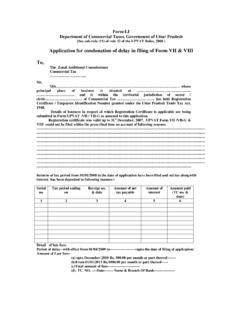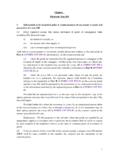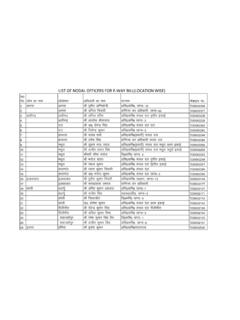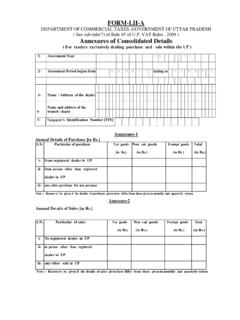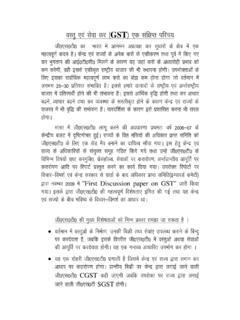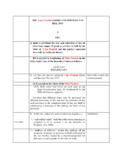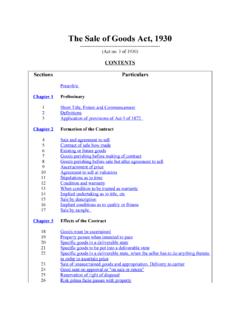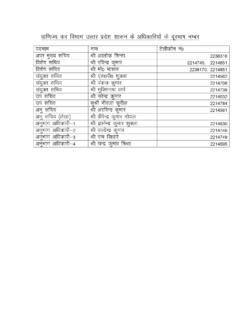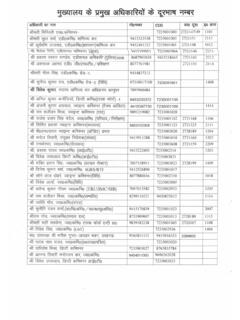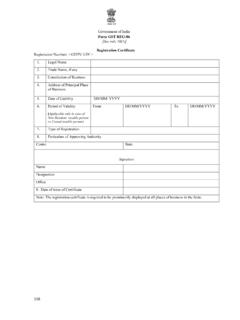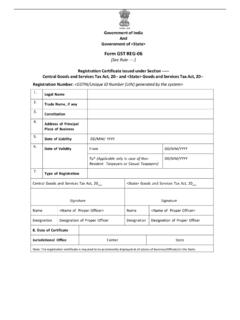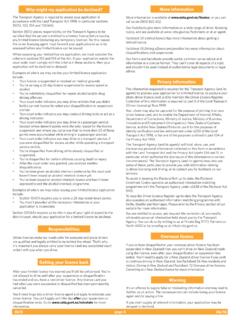Transcription of (Non-Core Amendment of API for Application for …
1 Date:-03-12-2018 # Module / Area form / Heading form Components/ details 1 Assessment & Adjudication Cross empowerment of Tax Officials,within a State/ UT As of now, Assessment can be done by jurisdictional authorities only, as per allocation of taxpayers. State authorities cannot issue orders against a taxpayer assigned to Centre and vice versa. Normally, an Application filed by taxpayer would be forwarded to the jurisdictional authorities concerned, meaning thereby that if a taxpayer (who is assigned to Centre) files any Application , the same should be made available to officers of Centre. Now this validation that State officer can assess taxpayers assigned to the concerned State only ( & vice versa) has been removed. Thus CBIC officials can now do assessment of a taxpayer assigned to a State (& vice versa), within the jurisdiction of a State/ UT.
2 CBIC or Model I States can now upload assessment orders, through API, irrespective of whether taxpayer is assigned to Centre or State/UT. Summary of the order in form GST DRC-07, can now be uploaded by Model I States and CBIC officers through G2G APIs. Similarly, Model II State officers can also make assessment orders and upload summary in form GST DRC-07, of the taxpayers assigned to Model I States or Centre. If the reply is filed consequent to a SCN or any notice, the same should be made available to the authority which has issued the said SCN or notice. Thus, if form GST DRC-03 is filed consequent to issue of SCN, the same should be made available to the authority which has issued the same for issuance of Drop Proceedings order in form GST DRC-05. Proceedings relating to scrutiny, summary assessment, determination of tax (73, 74), tax collected but not paid (76) and penalty etc.
3 Can be launched by any of the authority (State or Centre). Assessment of remanded cases will be handled by the authority which has issued the original order. Rectification of the order will also be carried out by the same authority. form GST DRC-07 consequent to enforcement proceedings u/s 129 or 130 can be uploaded by any authority irrespective of the registration approval authority of the taxpayer. For example, if a vehicle impounded by State authority and the taxpayer is assigned to Centre, in such cases, State authority can now upload the details of demand through GST DRC-07. Liability Register will be updated for Model I States and CBIC through API whereas for Model II States, the access will be directly through the portal. 2 Refund Filing of Monthly Refund applications by Quarterly Return filers As of now, taxpayers filing returns quarterly can file refund Application on quarterly basis only.
4 The system validates whether the tax payer has filed form GSTR-1 and form GSTR-3B for the corresponding period or not. As the functionality for filing quarterly refund Application was implemented in production recently and earlier these taxpayer were filing refund Application on monthly basis, so when they were trying to file refund Application for rest of the month of that quarter, tax payers were getting an error message that Refund has already been applied for January/February 2017-18 in the selected period. Please update selection to exclude already filed periods . Due to this error, the taxpayers who have already filed refund for say period Jan/Feb 2018 were not able to file refund Application for March 2018. Now, the restriction for applying refund on quarterly basis for quarterly return filers is removed, so that these tax payer would also be able to file refund Application on monthly basis.
5 This implies that the taxpayer can file monthly refund Application , but form GSTR 1 for the quarter must be filed. 3 Prosecution & Compounding Intimation about initiation of Prosecution Proceedings Tax official can (outside the system) file a complaint with the First Class Judicial Magistrate/Court for prosecution against a taxpayer. Taxpayer will be notified about initiation of prosecution on his dashboard and via Email / SMS. 4 GST Practioner Preparation of form GST APL-01 by GSTP, on behalf of taxpayer Tax payers can now select a GST Practitioner, to prepare an appeal in form GST APL-01, to be filed by them. The GSTP can save draft of the appeal Application form . The taxpayer and GSTP would be able to continue on the saved drafts of the appeal Application form , saved by either of them.
6 5 Advance Ruling Appeal against theAdvance Ruling given the Authority Once an advance ruling is issued by the authority and if the applicant or the taxpayer is aggrieved by such an advance ruling, they can file appealbefore the appellate authority. (refer Section 100 of the CGST Act, 2017) 6 Advance Ruling Rectification of mistake in the orderby the advance ruling authority or its appellate authority If there is any mistake in the order passed under Section 98 or 101, by the authority or the appellate authority, which is apparent from the record, the authority or the appellate authority can pass a rectification order for rectifying such mistake, if such mistake is noticed by the authority or by the appellate authority themselves or if such mistake is brought to its notice by the concerned or the jurisdictional officer or by the applicant/appellant, within a period of six months from the date of the order.
7 The applicant/appellant can make an Application to the authority/ appellate authority for rectification of the mistake. (refer Section 102 of the CGST Act, 2017) 7 Assessment & Adjudication Rectification of mistake in the orderby the Adjudicating Authority Errors or mistakes apparent on face of record can be rectified by the Adjudicating Authority on the basis of suo-moto rectification or upon receipt of Application from taxpayer, within a period of six months from the date of issue of such order. Rectification request can be given by taxpayer within 3 months from date of issue of order. (refer Section 161 of the CGST Act, 2017, Rule 142 of the CGST Rules, 2017 & form GST DRC-08) Date:-03-12-2018 # Module / Area form / Heading form Components/ details 1 Prosecution & Compounding Submission of Prosecution proposal by Tax Official & sanction by Commissioner The facility for submission of proposal, for initiation of prosecution against a taxpayer, to Commissioner for sanction, has been made available to tax officials of Model II State/ UT.
8 Tax official will file a complaint with the First Class Magistrate (outside the system), after taking sanction from the Commissioner (for prosecution). Taxpayer will be notified about initiation of prosecution on his dashboard and by Email / SMS. (refer Section 132(6) of CGST Act, 2017) Date:-28-11-2018 # Module / Area form / Heading form Components/ details 1 Payment Over the Counter (OTC) Payment Presently, Normal GSTINs, who has selected their Constitution of Business as Government Department or Others in Registration form , are able to create an OTC challan of more than Rs 10,000, in a Tax Period, on GST Portal. But other Users (irrespective of their Constitution of Business) are not able to create an OTC challan of more than Rs 10,000, in a given Tax Period, on GST Portal.
9 Now, every taxpayer can create an OTC challan of more than Rs 10,000, in a given Tax Period, on GST Portal, in both pre-login & post login modes (System check to limit OTC challan amount has been removed). (refer Law Committee MoM of 31/10/2018) Date:-13-11-2018 It is informed that, following new functionality will be made available on E-way Bill Portal from : 1. Checking of duplicate generation of e-way bills based on same invoice number: The e-way bill system is enabled in a way that if the consignor has generated one e-way bill on the particular invoice, then he or consignee or transporter will not be allowed to generate one more e-way bill on the same invoice number. If the transporter or consignee has generated one e-way bill on the consignor s invoice, then if any other party (consignor, transporter or consignee) tries to generate the e-way bill, the system will alert that there is already one e-way bill for that invoice, and further it allows him to continue, if he wants.
10 2. CKD/SKD/Lots for movement of Export/Import consignment: CKD/SKD/Lots supply type can now be used for movement of the big consignment in batches, during Import & Export also. Delivery challan and tax invoice need to accompany goods as prescribed in Rule 55 (5) of CGST Rules, 2017. 3. Shipping address in case of export supply type : For Export supply type, the Bill To Party will be URP or GSTIN of SEZ Unit with state as Other Country and shipping address and PIN code can be given as the location (airport/shipping yard/border check post/ address of SEZ), from where the consignment is moving out from the country. 4. Dispatching address in case of import supply type : For Import supply, the Bill From Party will be URP or GSTIN of SEZ Unit with state as Other Country and dispatching address and PIN code can be given as the location (airport/shipping yard/border check post/ address of SEZ), from where the consignment is entering the country.
